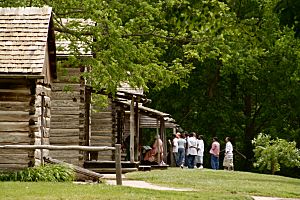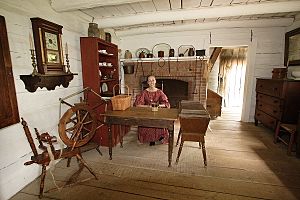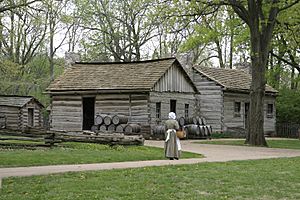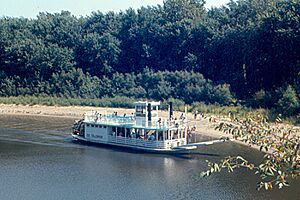Lincoln's New Salem facts for kids
Quick facts for kids
New Salem
Lincoln's New Salem State Historic Site
|
|
|---|---|
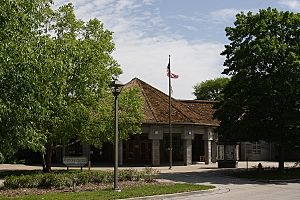
Welcome center, New Salem State Historic Site
|
|
| Country | United States |
| State | Illinois |
| County | Menard |
| Time zone | UTC-6 (CST) |
| • Summer (DST) | UTC-5 (CDT) |
Lincoln's New Salem State Historic Site is a special place in Menard County, Illinois. It's a rebuilt version of the old village of New Salem. This is where Abraham Lincoln lived when he was a young man, from 1831 to 1837.
During his twenties, the person who would become a U.S. President worked many jobs here. He was a boatman, a soldier, a store owner, and a postmaster. He also worked as a surveyor and split rails for fences. It was in New Salem that he was first chosen to be part of the Illinois General Assembly.
Lincoln moved from New Salem to Springfield in 1837. The village of New Salem was mostly empty by 1840 as other towns grew. After Lincoln passed away in 1865, people started gathering stories and old papers about the village. They also studied the remains of the old buildings.
In 1921, a state park opened on the village site. It was created to remember Lincoln and the early history of Illinois. In the 1930s, a group called the Civilian Conservation Corps rebuilt New Salem. They used the original building foundations to make it look like it did when Lincoln lived there. The village is about 15 miles northwest of Springfield. It is also about 3 miles south of Petersburg.
Contents
The Original New Salem Village
New Salem began in 1829. James Rutledge and John Camron built a gristmill on the Sangamon River. A gristmill grinds grain into flour. They then measured and sold land for shops and homes on the hill above the mill.
The town grew quickly at first. However, a nearby town, Petersburg, became the main government center for the county. This made New Salem shrink. By 1840, most people had left. The Sangamon River also wasn't good for steamboat travel, which hurt the town's growth.
In 1831, Abraham Lincoln's family moved to a new farm. Lincoln, who was 22, decided to live on his own. He arrived in New Salem by a flatboat. He stayed in the village for about six years.
During his time there, Lincoln worked as a shopkeeper and a soldier in the Black Hawk War. He owned a general store, was the postmaster, and a land surveyor. He also split rails and did other small jobs. Historians believe Lincoln never owned a home in New Salem. Most single men didn't own homes back then. He often slept in the tavern or his store and ate meals with a nearby family.
While living here, Lincoln ran for the Illinois General Assembly in 1832. He won easily in New Salem but lost the larger county election. He tried again in 1834 and won that time. Lincoln moved to Springfield, which was also in his election area, around 1837.
When Lincoln lived in New Salem, it was a busy place. It had a shop for barrel makers (a cooper), a blacksmith shop, and a wool mill. There were four general stores, including the Lincoln-Berry General Store. The village also had a tavern, a grocery, and two doctors' offices. Other businesses included a shoemaker, a carpenter, a hat maker, and a tanner. There was a schoolhouse that also served as a church. Many families lived in homes with gardens and shared pastures. New Salem was home to 20 to 25 families at a time. It was a commercial village with young business owners and craftspeople. They were all trying to start new lives on the frontier.
Lincoln's New Salem State Historic Site Today
In 1906, William Randolph Hearst bought the village land. He then gave it to the Old Salem Chautauqua Association. In 1919, the land was given to the State of Illinois. The site first opened to visitors on May 19, 1921.
Over time, buildings were rebuilt on the original foundations. Most of this work was done by the Civilian Conservation Corps during the Great Depression. They used old documents, interviews with former residents, and archaeological studies. Today, the site is called Lincoln's New Salem State Historic Site. It has 23 buildings, mostly log cabins. People dressed in old-fashioned clothes work there. They show what life was like when Lincoln lived there.
The homes, shops, and businesses are filled with tools, objects, and furniture from that time. Many of these items came from local farms and homes. The park is 700 acres and includes many woodlands.
Twenty-two of the village buildings are rebuilt. However, one log cabin, the Onstot Cooper Shop, is original. It had been moved to Petersburg in 1840 by Henry Onstot. In 1922, it was brought back to New Salem. Archaeologists believe it is on its first foundation. Much of the town was recreated using old papers and drawings. These were made by former residents who were interviewed in the late 1800s.
The Steamboats Talisman
In 1832, a large river steamer named Talisman traveled to central Illinois. It was 136 feet long and weighed 150 tons. It came from Cincinnati, Ohio, down the Ohio River, and up the Mississippi and Illinois Rivers. Then it went into the Sangamon River. Lincoln helped clear things from the riverbanks for the Talisman's trip upstream. He also helped pilot the boat back to Beardstown.
In the summer of 1961, a new steamboat was built. It was also named Talisman. This boat was a smaller version of the original. It weighed 40 tons and was 73 feet long. It had an upper cabin and a 60 horsepower diesel engine. This recreated steamboat came to New Salem by river.
The new Talisman had a landing next to the Rutledge Camron Saw and Grist Mill. Visitors could take short boat rides on the river. But just like the first Talisman, this boat had problems with low water levels. It became harder to navigate over the years. In 1998, the river dam at Petersburg was no longer used, and water levels became too low. The boat eventually got stuck a few miles upstream from the historic site. It then sat on the land, like a large decoration. On November 19, 2021, the boat was taken apart in a controlled burn.
Visiting Lincoln's New Salem
Lincoln's New Salem is a popular place to visit. About 600,000 people came to see it in 2006. It was added to the National Register of Historic Places in 1972. It was listed under the name Lincoln's New Salem Village. The historic site has a visitor's center with exhibits and a theater.
There are also trails for walking. The Mentor Graham Trail is 0.75 miles long. The Volksmarch Trail is 6 miles long. The state park also has 200 campsites. One hundred of these sites have electrical hookups.
See also




